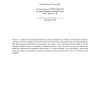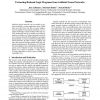236 search results - page 2 / 48 » Learning Teleoreactive Logic Programs from Problem Solving |
MLG
2007
Springer
13 years 11 months ago
2007
Springer
Abstract. There are many connections between graph mining and inductive logic programming (ILP), or more generally relational learning. Up till now these connections have mostly be...
GECCO
2011
Springer
12 years 8 months ago
2011
Springer
—A number of representation schemes have been presented for use within Learning Classifier Systems, ranging from binary encodings to Neural Networks, and more recently Dynamical ...
RC
2002
13 years 5 months ago
2002
Existing interval constraint logic programming languages, such as BNR Prolog, work under the framework of interval narrowing and are deficient in solving systems of linear constrai...
APIN
2010
13 years 5 months ago
2010
Artificial neural networks can be trained to perform excellently in many application areas. While they can learn from raw data to solve sophisticated recognition and analysis prob...
ILP
2004
Springer
13 years 10 months ago
2004
Springer
Abstract. Logic Programs with Annotated Disjunctions (LPADs) provide a simple and elegant framework for integrating probabilistic reasoning and logic programming. In this paper we ...


